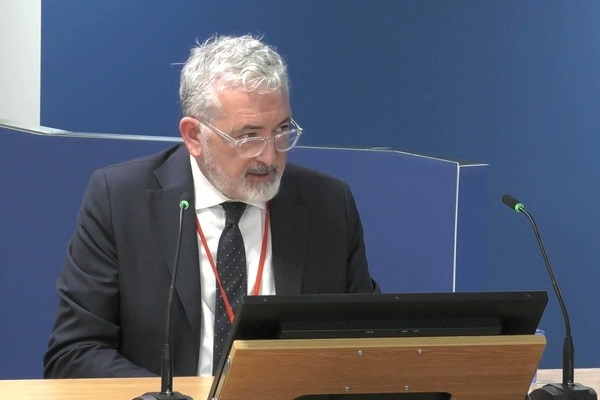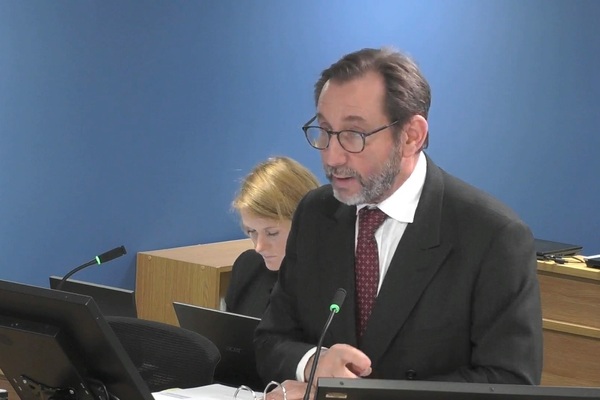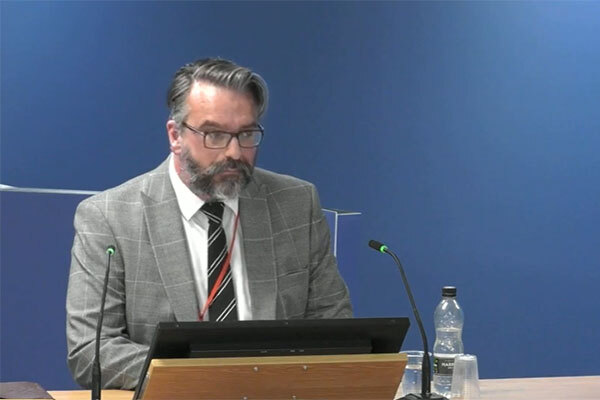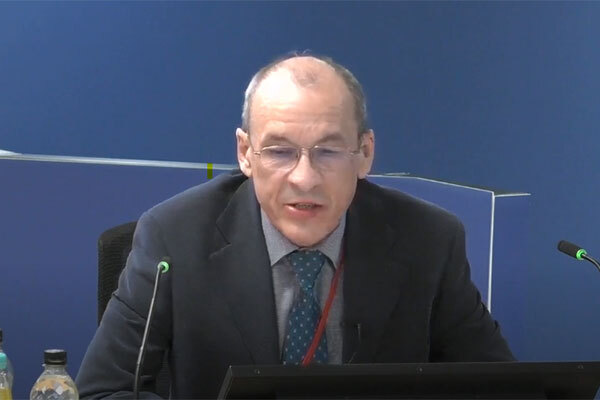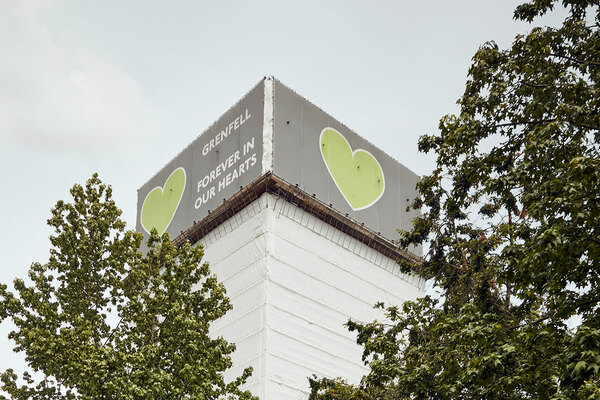Grenfell Tower Inquiry diary week 41: ‘We should do nothing. This is not the sort of website we should be responding to’
This week saw the return of Robert Black, chief executive of Kensington and Chelsea Tenant Management Organisation (KCTMO), before the inquiry turned its attention to the defective smoke control system in the tower. Dominic Brady reports
‘We should do nothing. This is not the sort of website we should be responding to’
On Monday, Mr Black (pictured above) returned to give further evidence as the inquiry sought to understand the way KCTMO had dealt with tenant complaints, particularly those that emanated from Grenfell Tower and related to safety.
Lead counsel to the inquiry Richard Millett QC began the day by showing Mr Black a blog post by Grenfell Tower resident Ed Daffarn which foreshadowed a “serious loss of life” in the tower as a result of fire safety defects.
The blog, posted eight months before the fire in June 2017, has become a symbol of the failure of KCTMO to heed concerns of residents in the tower, and this week the inquiry looked specifically at how this blog was dealt with.
Mr Black claimed that when he saw the blog he would have sent it onto his health and safety advisor, Janice Wray, to get her views. Mr Millett noted that there was no record of such an email being sent and the only reference to Mr Daffarn’s blog was in an email from Barbara Matthews, former executive director of financial services and IT at KCTMO, to Ms Wray.
It read: “Janice, I have spoken to Robert and he agrees that we should do nothing. This is not the sort of website we should be responding to.”
Far from addressing the concerns put forward by Mr Daffarn, an email chain shown to the inquiry revealed KCTMO staff seeking legal advice on whether the blog post was libellous.
“Truda − could any of the allegations be described as libellous?” asked assets and regeneration director Peter Maddison in December 2016. “The comments are scaremongering at the least. Do we need to respond to reassure residents?”
The blog had in fact been blocked on KCTMO’s servers, which meant the majority of staff could not read it. Mr Black said this was done following “employment and legal advice”.
“So after consulting the police, HR and our lawyers, they advised us that, in terms of duty of care, you should block them where it feels it’s attacking our staff in terms of – in a libellous or horrible way,” Mr Black said.
“The problem with that approach, do you agree, is that if you take a blanket approach of not responding to anything in blogs, you might miss allegations which are actually not only true, but important?” said Mr Millett. “That’s a risk, isn’t it?”
“There is a risk, yes, but in a sense, it’s for us as an organisation trying to manage… in a sense, there wasn’t just one blog, you know, across all local authorities you have these, and it’s quite difficult just to keep on top of them in terms of… and that’s just the position you find yourself in,” Mr Black replied.
‘Wasn’t it in your interests to have Judith Blakeman silenced because she was continually raising concerns on the part of the residents of Grenfell Tower?’
At the same time, concerns were also being raised by a councillor whose ward covered Grenfell Tower – Judith Blakeman, who was also a board member at KCTMO and the council’s housing and property scrutiny committee (HPSC).
In one email, Ms Blakeman told Mr Black that she had more than 300 email exchanges with KCTMO regarding Grenfell Tower in 2015 alone, which Mr Black admitted was a lot.
Rather than engaging with concerns raised by Ms Blakeman, Mr Black instead sought to understand whether her positions on KCTMO and HPSC represented a conflict of interest. He did so in the run-up to a crucial health and safety report going before the committee.
In an email sent to fellow councillors on the committee, Mr Black said that Ms Blakeman’s concerns “should not be entertained”.
Mr Black said he was concerned about the way in which Ms Blakeman chose to raise her concerns, but admitted that it would have been “more sensible” for him not to get involved.
Mr Millett (pictured above) asked: “Wasn’t it in your interest, though, to have Judith Blakeman silenced because she was continually raising, as we’ve seen, concerns, ill-feeling on the part of the residents of Grenfell Tower, and that’s what really lay behind this?”
“No, I don’t think so,” Mr Black replied.
‘Health and safety concerns were more talk than action’
On Tuesday, the inquiry heard from Graham Webb (pictured above), managing director at Repairs Direct, which provided all the responsive repairs to all of the Royal Borough of Kensington and Chelsea’s (RBKC) housing stock.
The inquiry looked at the large backlog of repairs and fire risk assessments (FRA) that existed when Mr Webb took over in 2016 and how he approached it.
Mr Webb said no one at Repairs Direct was “owning” the FRA actions and that one of his first steps was to allocate this job to a specific employee.
Despite this, the inquiry heard a number of accounts from residents, specifically on the Lancaster West Estate where operatives had offered to remove self-closing devices from fire doors.
Counsel to the inquiry Andrew Kinnier QC asked: “Are you able to explain why a Repairs Direct operative appears to have offered to remove a self-closing device?”
“No, I’m not able to explain that, and I’m disappointed if that were the case,” Mr Webb responded.
Questions over the company’s health and safety record were also uncovered in a witness statement from former employee Shannon MacInnes.
In her statement to the inquiry, Ms MacInnes said: “I did not feel health and safety was a priority at Repairs Direct. This was one of the reasons why I eventually left – health and safety concerns were more talk than action.”
Mr Webb disagreed with Ms MacInnes’ assessment and said he was “disappointed” by her comments.
Another former employee’s witness statement was put to Mr Webb, in which they accused Repairs Direct of improving customer satisfaction rates by a selective approach to feedback surveys.
Samantha Burrell, who worked at the company’s call centre, said they were expected to maintain customer satisfaction rates of 90% to 95%.
“When I commenced employment with [Repairs Direct], the ethos was to select specific jobs which was almost a guarantee positive reaction to the works, for example a tap repair, to bolster that percentage,” her statement read.
Asked whether he recognised these methods, Mr Webb said: “Absolutely not. My firm belief was that calls were selected at random.”
‘You didn’t give any consideration to internal fire spread when it came to the smoke control system and its ability to maintain compartmentation?’
On Wednesday, the inquiry turned its attention to the topic of Grenfell Tower’s smoke control system, which was widely criticised in Dr Barbara Lane’s expert report.
The topic began with opening statements from representatives for the bereaved families, PSB UK, which designed the system, and the Fire Brigades Union.
Much of the focus fell on the type of dampers used on the tower, which Dr Lane said in her report were non-compliant with British standards.
Representative for the bereaved Stephanie Barwise QC said the dampers used were the “lowest possible standard”. When designing the system, PSB elected to use “fire dampers” which close when fire is detected, whereas the system demanded “smoke control dampers” which close when smoke is detected.
She argued that this difference was “highly material” as it is believed that on the night of the fire smoke leaked out of the dampers, contributed to the build up in lobbies and prevented escape and rescue efforts.
PSB’s representative, Lee Bennett QC, contended this point, claiming that the failure to include the correct type of damper did not contribute significantly to the outcome of the fire.
He said: “In the context of a catastrophic cladding fire, such as happened at the tower, even if the alleged failings of the system were to be established with confidence, PSB presently sees no basis upon which to reasonably draw any conclusion that such failings caused or materially contributed to the outcome of the fire.”
On the final day of evidence, the inquiry heard from Paul Hanson (pictured above), principal fire engineer at RBKC, who signed off the smoke control system.
Mr Hanson was taken through a number of failings with the system and asked to explain how it was they were eventually signed off.
Much of his reasoning boiled down to the fact that RBKC’s building control department had made swingeing budget cuts in 2011 and 2015, in which a crucial building regulation engineering group – or BREG engineer – was made redundant.
Mr Hanson explained: “When we decided to make our BREG engineer redundant, we’re relying on the professionalism of the installer, designer, and because I’ve not been a BREG engineer, I’m not used to the expectation of how the commissioning report should be written.”
He said he would have felt “a lot more confident” in signing off the system had a BREG engineer been involved as he was only familiar with certain parts of the building regulations, namely B1 and B5 in Approved Document B.
Counsel to the inquiry Kate Grange QC asked: “Does that mean that you didn’t give any consideration to B3, that’s internal fire spread, when it came to the smoke control system and its ability to maintain compartmentation?”
“That’s correct, yeah,” Mr Hanson replied.
The inquiry continues next week with evidence from other witnesses involved in the smoke control system.
Sign up for our weekly Grenfell Inquiry newsletter
Each week we send out a newsletter rounding up the key news from the Grenfell Inquiry, along with the headlines from the week
Already have an account? Click here to manage your newsletters

